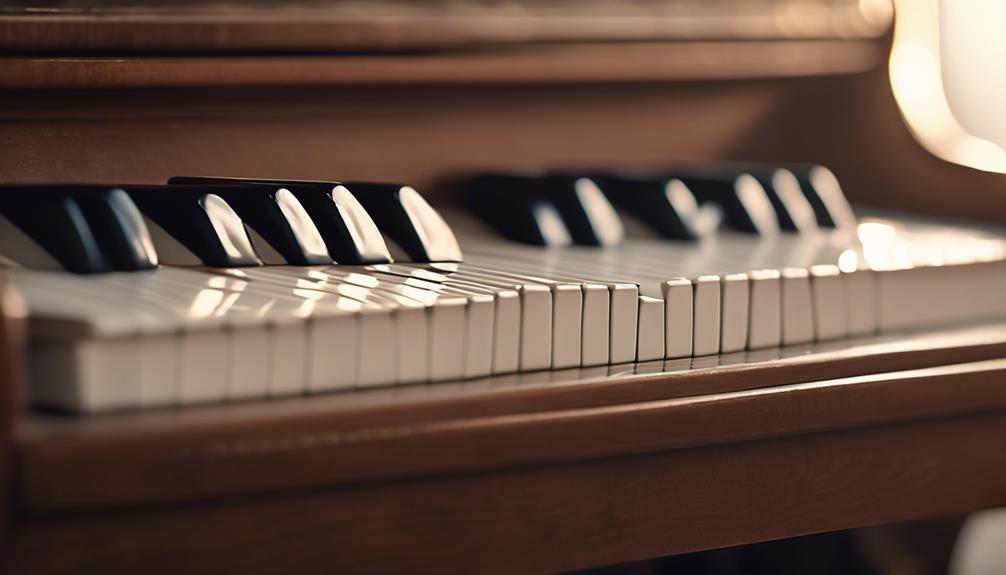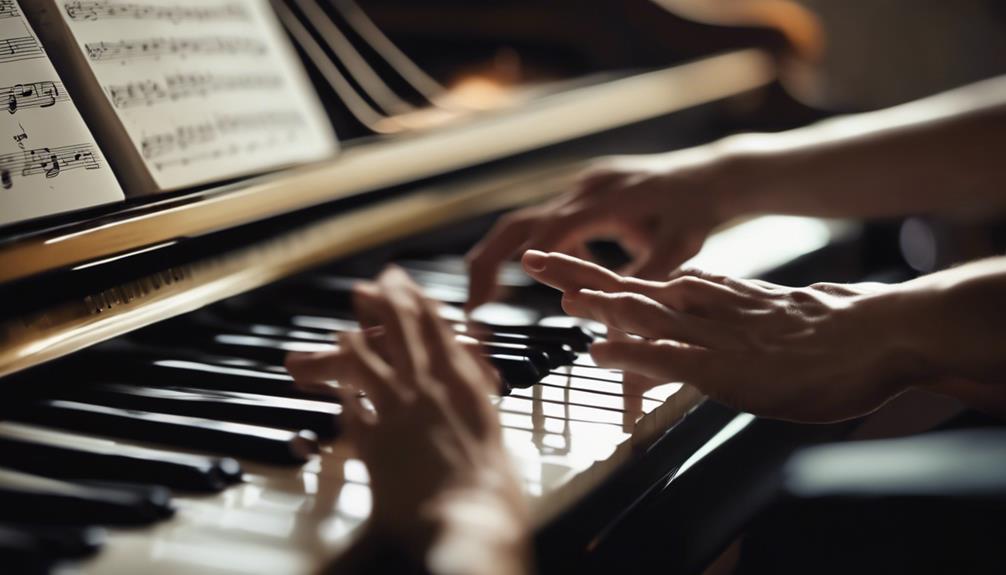When exploring piano rhythm patterns, you’ll find that mastering quarter note rhythms is just the beginning. Establishing a strong pulse lays the foundation, but incorporating syncopation and various subdivisions can truly transform your playing.
By experimenting with both right and left hand techniques, you can create intricate and engaging patterns that showcase your skill. Have you considered how octave doubling or varied chord inversions might add depth to your music?
Developing these techniques not only enhances your musicality but also prepares you for captivating piano performances. So, what’s the next step in refining your rhythmic approach?
TL-DR
- Experiment with quarter, eighth, and sixteenth note variations to create diverse rhythm patterns.
- Incorporate syncopation to develop off-beat grooves and rhythmic complexity.
- Use subdivisions of the beat and arpeggios to add dynamic layers to your playing.
- Practice consistent tempo and pulse to ensure smooth transitions between rhythms.
- Apply proper hand positioning and technique to maintain accuracy and prevent strain.
Basic Chord Shapes

Mastering basic chord shapes like C major, E major, F major, and F minor is vital for building a strong foundation in piano playing. When you’re learning piano, focusing on these basic chords helps you understand the structure of many songs.
Place your hand on the keyboard, ensuring that every note in the chord is pressed correctly. This practice builds muscle memory, making shifts between chords smoother over time.
To start, play these chords as quarter notes. This will help you maintain a steady rhythm, which is essential for any piece you’ll play. As you press each chord, feel the connection between your fingers and the keys, ensuring that every note rings out clearly. Don’t rush through this step; developing a solid technique now will pay off later.
Using the sustain pedal can enhance your practice sessions by creating a more flowing and connected sound. This pedal keeps the notes ringing even after you lift your fingers, allowing you to hear how the chords blend together.
Once you’ve mastered these basic shapes and their progressions, you’ll be ready to tackle more complex piano rhythm patterns.
Establishing Pulse
Once you’ve got a handle on basic chord shapes, it’s important to establish a consistent pulse to bring your playing to life. Using quarter notes to create this pulse is a great starting point. Count to four in every measure, emphasizing the strong beats (1 and 3), while the weak beats (2 and 4) provide a natural ebb and flow. This consistent counting helps you maintain a steady tempo and keeps your rhythm tight.
To get started, practice playing chord progressions with quarter notes. Focus on:
- Counting aloud: Say ‘1, 2, 3, 4’ as you play each quarter note.
- Using the sustain pedal: Apply it strategically to smooth transitions and add a strumming effect.
- Maintaining tempo: Make sure your timing is consistent, especially when changing chords.
Incorporate note subdivisions to add variety and complexity to your rhythm. Dividing beats into smaller units, like eighth notes or sixteenth notes, creates more intricate patterns. For now, stick to quarter notes to build a strong foundation, but be mindful of how subdividing notes can enhance your rhythm down the line.
When you establish a pulse with quarter notes, it lays the groundwork for more advanced rhythms and keeps your playing dynamic and engaging.
Quarter Note Rhythms

To truly grasp quarter note rhythms, start by focusing on playing a single note or chord on each beat in a 4/4 time signature. This means you’ll play one note per beat, counting to four in each measure. Emphasize the strong beats, particularly beats 1 and 3, to maintain a solid structure.
When practicing, use your left hand to play these quarter notes, as it often provides the rhythmic foundation in many pieces. This focus helps establish a steady pulse, essential for any musical performance.
You can also experiment with adding eighth notes to your practice to see how different rhythms interact. For example, alternate between quarter notes and eighth notes in different measures to add variety and complexity.
Don’t forget to use the sustain pedal between quarter notes to create a smoother, more connected sound. This technique helps bridge the gaps between notes, making your playing sound more cohesive.
Right Hand Techniques
Incorporating effective right hand techniques can greatly enhance your piano playing. One essential skill is the thumb-under technique, which lets you navigate between notes and chords smoothly. By tucking your thumb under your fingers, you maintain fluidity and avoid any awkward pauses that break the rhythm.
To create rhythmic variety, experiment with different articulations like staccato and legato. While staccato adds a crisp, detached sound, legato connects notes seamlessly, offering a more flowing feel. Syncopation, emphasizing off-beat rhythms, can also add a unique twist to your right hand patterns, making your music more engaging.
Here are some key techniques to focus on:
- Thumb-under technique: Ensures smooth movements between notes and chords.
- Finger independence: Practice exercises to improve dexterity and control.
- Finger substitutions: Maintain fluid motion while playing complex rhythms.
Finger independence is essential for mastering complex rhythm patterns. Spend time on exercises designed to improve dexterity and control in your right hand. This will help you play intricate pieces with greater ease.
Left Hand Techniques

Mastering effective left hand techniques can greatly enrich your piano playing, often providing the foundational rhythm that drives the music. Every time you sit at the piano, think of your left hand as the backbone of your performance. Octave jumps can create a strong bass foundation, adding depth to your sound. Moving between octaves not only makes your playing more dynamic but also enhances the overall rhythm pattern.
Incorporating broken chords or arpeggios can add movement and texture to your music. Instead of playing a chord all at once, break it down and play each note individually. This can make your left hand part more interesting and engaging. Experiment with different rhythmic patterns, such as alternating bass notes or syncopated rhythms, to keep your playing lively.
Maintaining a steady beat is important, but don’t be afraid to introduce variations like off-beat accents or anticipatory notes. These small changes can add a layer of complexity and excitement to your music.
Lastly, use pedal techniques like sustain or staccato to enhance the left hand’s contribution to the overall rhythm and groove. With consistent practice, your left hand will become a powerful tool in your piano repertoire.
Using Inversions
Rearranging the notes of a chord to create different voicings, inversions can smooth out your chord progressions and minimize hand movement. When you use inversions, you’re fundamentally shifting the chord’s notes around, allowing for a more fluid and connected sound. This technique is particularly useful when you’re shifting between chords that are close to each other.
For the first time, try starting with basic triads before moving on to more complex chords with four notes. Practicing inversions will help you get comfortable with these shifts and enhance your overall playing.
When working on inversions, focus on:
- Root Position: The original chord shape.
- First Inversion: Move the root note up an octave.
- Second Inversion: Move both the root and the third up an octave.
By mastering these, you’ll be able to add richness and complexity to your playing. For example, if you’re playing a C major chord, try using the second and fourth notes (E and G) in different positions to create smoother changes. This can make your chord progressions sound more professional and polished.
Incorporating inversions into your practice routine will surely improve your ability to play chord progressions with ease and fluidity.
Single Note Patterns

When you introduce single note patterns into your piano playing, you add a layer of melodic interest that enhances your overall sound. These patterns involve playing individual notes in a rhythmic sequence, which can bring your music to life with texture and dynamics. By experimenting with different rhythms such as quarter notes, eighth notes, or sixteenth notes, you can inject variation and keep your listeners engaged.
Single note patterns allow for creative improvisation, letting you explore new melodic phrases that complement your chord progressions. You can combine these single notes with chordal accompaniment to create a more complex and engaging sound, adding harmonic embellishments that make your music richer and more nuanced.
Don’t hesitate to play around with different tempos and note durations to find the perfect single note pattern for your piece. This experimentation can lead to unique melodic phrasing that sets your music apart.
Whether you’re playing a slow ballad or an upbeat tune, single note patterns can be tailored to fit any style, making them an essential tool in your piano-playing arsenal. So, start incorporating these patterns and watch your music transform!
Playing Octaves
When playing octaves, you’ll need to focus on proper hand positioning to guarantee accuracy and prevent strain.
Experimenting with dynamic variation techniques can add expressiveness and prevent your playing from sounding monotonous.
Consistent spacing between octaves in your left hand will help maintain a balanced and rich sound.
Proper Hand Positioning
To play octaves properly, place your thumb and pinky on the corresponding keys, making sure your hands are correctly aligned. Start by focusing on your finger placement and wrist alignment.
Your thumb and pinky should rest comfortably on the keys, while your wrist remains level and relaxed. This positioning helps prevent tension and promotes fluid movement.
Maintaining a slight finger arch is vital for even pressure across the keys. This ensures each note within the octave is struck with balanced force. Avoid flattening your fingers, as this can lead to uneven sound and increased strain over time. Practice pressing down with consistent pressure to achieve a harmonious tone.
For best performance, pay attention to spacing accuracy and hand strength. Accurate spacing between your thumb and pinky will help you hit the right notes consistently. Building hand strength is essential for sustaining octaves, especially during complex passages.
- Finger placement and wrist alignment: Keep your thumb and pinky properly positioned and wrists relaxed.
- Finger arch and even pressure: Maintain a slight arch in your fingers for balanced sound.
- Spacing accuracy and hand strength: Focus on consistent spacing and strengthen your hands with practice.
Dynamic Variation Techniques
For dynamic variation in playing octaves, utilize wrist rotation and apply arm weight to achieve a consistent sound across different registers. This technique guarantees you’re not only maintaining control but also enhancing rhythmic dynamics and harmonic shifts in your performance.
When you incorporate octaves, you can add depth to bass lines and create a sense of power in melodies, amplifying the overall dynamics of a piece.
Incorporate tempo fluctuations and expressive phrasing to bring your octaves to life. By varying your speed and emphasizing certain notes, you can make your playing more engaging and emotionally resonant.
Experiment with articulation variations to give different characters to each octave you play, whether it’s a staccato for a sharp, detached sound or legato for smooth, connected notes.
Melodic accents are vital when playing octaves. Emphasize specific notes to highlight important parts of the melody and create a dramatic flair. Balance is key; don’t overuse octaves, but integrate them thoughtfully to elevate the intensity and expressiveness of your musical passages.
Mastering these dynamic variation techniques will make your piano performance more compelling and nuanced.
Eighth Note Variations

How can you add more energy and movement to your piano playing? Eighth note variations are the answer. By immersing yourself in each beat into two equal parts, you can create intricate and dynamic rhythms that breathe life into your music.
Here are a few ways to explore eighth notes:
- Improvisation tips, rhythmic exploration: Experiment with different combinations of eighth notes to develop unique rhythmic patterns. This rhythmic exploration can lead to fresh improvisational ideas.
- Creative phrasing, rhythmic complexity: Use eighth notes to add layers of rhythmic complexity to your phrasing. This will make your playing more engaging and sophisticated.
- Jazz influences, rhythmic expression: Channel your inner jazz musician by using eighth notes to enhance your rhythmic expression. Jazz relies heavily on these patterns to create its signature groove and swing.
To master eighth note variations, practice scales or simple melodies using only eighth notes. This will help you develop a strong sense of timing and precision. Additionally, try incorporating syncopation and varying the emphasis on different beats to make your patterns more interesting.
Eighth notes can greatly enhance the groove and flow of your piano playing, especially in genres like jazz and pop. Delve into these variations and watch your piano skills soar!
Sixteenth Note Patterns
When you tackle sixteenth note patterns, start with basic rhythms to build a solid foundation.
You’ll find that syncopation techniques can add an exciting layer of complexity to your playing.
Practice hand coordination exercises to master these patterns and achieve fluidity in your performances.
Basic Sixteenth Note Rhythms
Mastering basic sixteenth note rhythms is essential for adding energy and complexity to your piano playing. These notes divide each beat into four equal parts, creating intricate rhythms that can elevate your performance.
When you focus on sixteenth note improvisation, you’ll discover how to weave these patterns seamlessly into your music, making your play more dynamic and engaging.
To get started, practice common sixteenth note patterns consistently. This helps develop speed and accuracy, critical elements for mastering sixteenths. Here’s how you can begin:
- Play four notes per beat to get a feel for the steady tempo.
- Alternate between two notes on each beat to introduce variety.
- Combine sixteenth notes with other rhythms to add complexity.
Developing these skills allows you to create dynamic contrasts, which is key to sixteenth note expression. As you practice, pay close attention to maintaining a steady tempo and precision, which are essential for keeping your rhythms clean and impactful.
Experiment with different combinations and don’t be afraid to push your boundaries. With dedication, you’ll find that sixteenth note rhythms bring a new level of sophistication and excitement to your piano compositions.
Syncopation Techniques
Syncopation techniques in sixteenth note patterns can instantly transform your piano playing by emphasizing off-beat notes to create rhythmic tension and excitement. By focusing on syncopation dynamics, you can add a whole new layer of complexity and interest to your playing styles.
Start by experimenting with syncopated rhythms, accenting the ‘and’ of the beat. This simple shift can add significant musical expression and elevate your performance.
To create rhythmic tension, try using a 3-3-2 grouping of sixteenth notes. This pattern, where you accent weaker beats, creates an off-beat feel that brings a dynamic and unexpected twist to your music.
Syncopation isn’t just about timing; it’s about creating a groove that makes listeners want to tap their feet. You can achieve this by delaying the onset of some notes or playing them slightly before the beat.
Syncopated sixteenth note patterns are fantastic for adding a lively and engaging rhythmic texture. Incorporate these techniques to enhance your groove creation and make your music more compelling. Your audience will appreciate the added energy and complexity, making your piano playing truly stand out.
Hand Coordination Exercises
Building on the excitement of syncopation techniques, let’s focus on hand coordination exercises to master sixteenth note patterns. These exercises are essential for developing finger independence, managing rhythmic challenges, and maintaining precise tempo control.
Start by subdividing each beat into four equal parts, using a metronome to keep your tempo steady. Play simple patterns like 1-e-and-a, gradually moving to more complex variations.
To master hand coordination, practice playing different rhythms with each hand simultaneously. Start slowly, ensuring each hand moves independently and precisely. Here are some tips to enhance your practice:
- Subdivide the Beat: Break each beat into four parts using a metronome for accurate timing.
- Start Simple: Begin with basic 1-e-and-a patterns before tackling more intricate rhythms.
- Gradually Increase Speed: Slowly raise the tempo to build dexterity and control.
Focus on the consistency of your rhythm and clarity of each note. By incrementally increasing the speed, you’ll develop the ability to handle faster and more complex rhythmic patterns.
These exercises not only improve finger independence but also help you overcome rhythmic challenges, making your playing more fluid and controlled. Keep practicing, and you’ll see significant progress in your hand coordination and overall piano performance.
Expanding With Arpeggios

When you expand chord shapes by doubling the top note down an octave, you create a fuller sound and enhance melodic possibilities. This technique invites melodic embellishments and opens up a world of arpeggio variations.
By exploring these arpeggio extensions, you’ll notice an increase in harmonic richness and depth in your playing.
Start by developing an arpeggiating pattern beginning from the bottom note, ascending to the top note, and then descending. This flowing effect adds a dynamic layer to your music.
Use arpeggios to fill all sixteenth note subdivisions, which introduces complexity and depth. Think of it like guitar fingerpicking; aim for clarity and control in each note.
To further your creative improvisation, experiment with different arpeggiating patterns and speeds. This type of arpeggio exploration will notably enhance your musical expression.
Try incorporating variations in your practice sessions to discover what works best for your style.
Syncopation Techniques
Often, you’ll find that adding syncopation to your piano rhythms injects a compelling groove and unexpected energy into your music. Syncopation involves emphasizing off-beat rhythms, creating a dynamic interplay between tension and release. By exploring exploration variations, you can dive into rhythmic exploration and add a layer of rhythmic complexity to your compositions.
To start, focus on placing notes on weak beats or between strong beats. This technique disrupts the regular rhythmic pattern, creating tension and keeping listeners engaged.
Here are some practical methods to incorporate syncopation:
- Use dotted notes: Extend the duration of a note beyond its usual length to emphasize off-beat timing.
- Tie notes: Connect two notes across a beat, producing a syncopated effect that bridges the expected accents.
- Unexpected accents: Emphasize notes that usually remain unaccented to create surprising rhythmic shifts.
Syncopation isn’t just about adding complexity; it’s also about groove development. By shifting the emphasis in your rhythm, you create a lively, unpredictable feel that breathes life into your music. Experiment with these syncopation techniques to transform your piano playing and captivate your audience with rhythmic innovation.
Varied Chord Inversions

Just as syncopation adds rhythmic excitement, varied chord inversions can bring harmonic depth and smooth movement to your piano playing. By rearranging the notes of a chord, you’re able to create smoother progressions between chords. This technique not only enhances the harmonic depth of your music but also helps maintain a consistent bass note progression, making your accompaniment sound more cohesive.
One of the key inversion benefits is the musical richness they add to your pieces. When you use different chord inversions, you introduce subtle variations in sound that can make your performance more engaging and less predictable. This creative exploration allows you to find new ways to express the same harmonic ideas, keeping your music fresh and interesting.
Varied chord inversions also contribute to a more dynamic accompaniment. Instead of playing the same chord in its root position, experimenting with inversions can give your playing a more complex and textured feel. This not only enhances the listener’s experience but also keeps you as a pianist more engaged with your own music.
Octave Doubling
Octave doubling, by playing the same note in different octaves simultaneously, creates a fuller and richer sound in your piano music. This technique is a powerful tool for melody expansion, allowing you to broaden the reach and impact of your tunes. It can also lead to significant harmonic enrichment, enhancing the emotional depth and complexity of your pieces.
When you use octave doubling, you’re able to:
- Add depth and power to your chord progressions or melodies, making them more compelling.
- Enhance the overall texture of your music, giving it a more dynamic and layered feel.
- Strategically highlight important moments in a piece, adding intensity and emphasis where needed.
Experiment with doubling specific notes in chords or melodies to emphasize certain tones and create a unique sonic quality. By doubling key notes, you can bring out subtleties that might otherwise be lost in a single octave.
Use this technique to add intensity to your piano playing, especially during climactic points in your music. Whether you’re working on a classical piece or a modern composition, octave doubling can transform your piano playing, making it more vibrant and impactful.
Combining Techniques

Combining various piano techniques enables you to create richer, more engaging rhythm patterns that fascinate your audience. Start by integrating basic chord shapes with rhythmic patterns using quarter notes. This sets a strong pulse, forming the foundation of your rhythm.
To add complexity, incorporate right-hand techniques like inversions and single-note bass lines. These elements enhance your rhythm’s depth and texture.
Experimenting with eighth and sixteenth notes allows you to introduce advanced rhythmic variations. Utilize thumb patterns and pickup notes to craft intricate rhythms, adding layers of interest to your playing.
Expanding your rhythmic repertoire further with arpeggiating patterns and chord extensions results in a fuller, more dynamic sound.
Challenge yourself by exploring advanced concepts like syncopation, octave doubling, and varied chord inversions. These techniques offer a fusion of techniques that can transform your rhythm patterns, making them more engaging and versatile.
Next up, learn about piano chord inversions in this guide.
